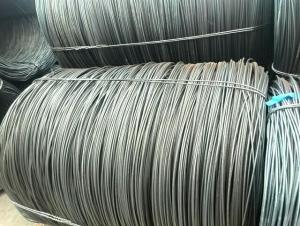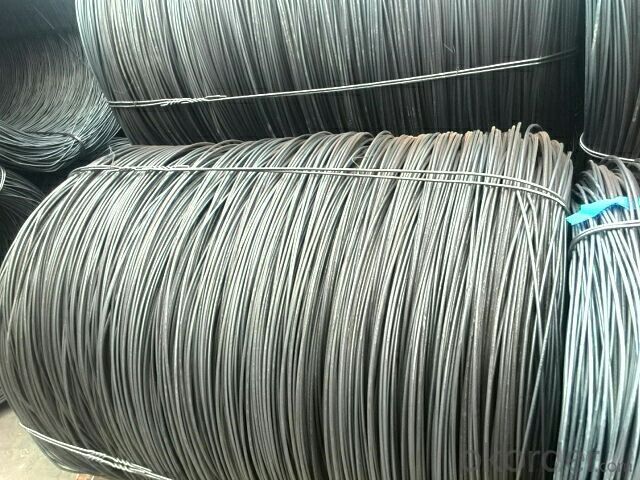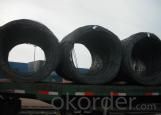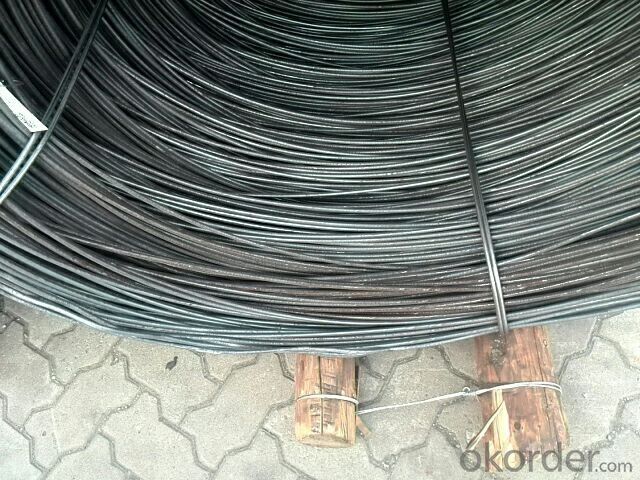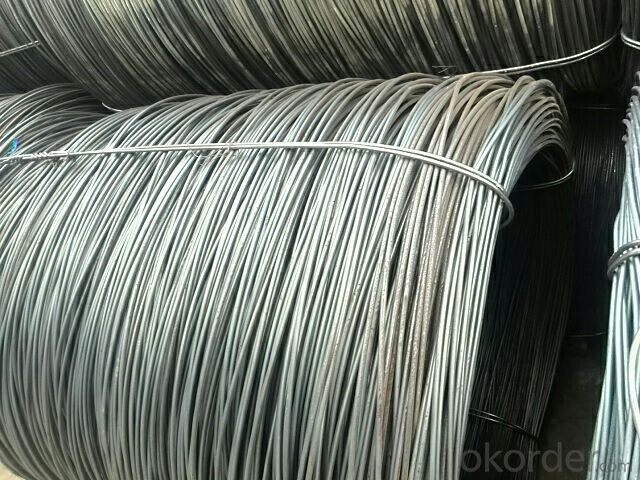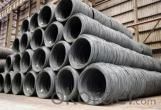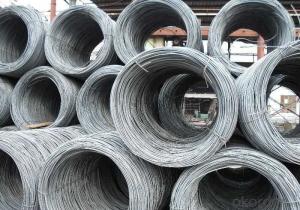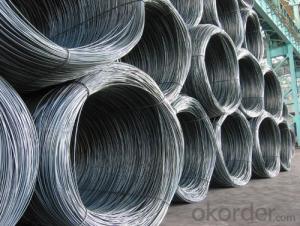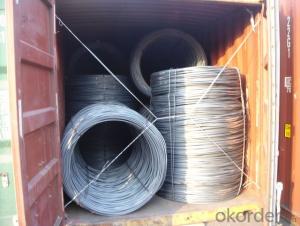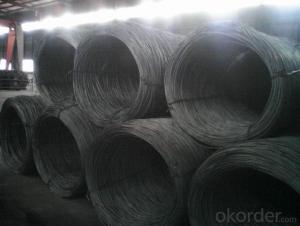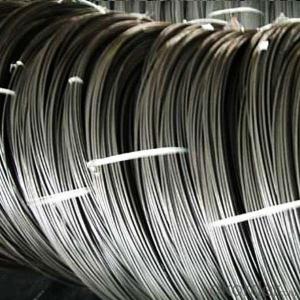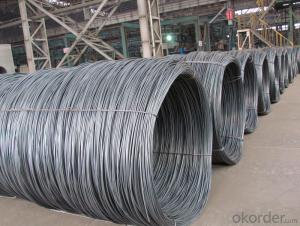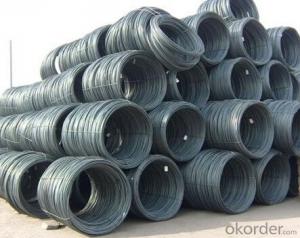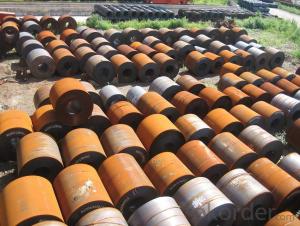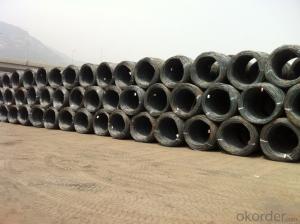Wire Rod Q195 With High Quality
- Loading Port:
- China Main Port
- Payment Terms:
- TT or LC
- Min Order Qty:
- -
- Supply Capability:
- -
OKorder Service Pledge
OKorder Financial Service
You Might Also Like
Product Description:
OKorder is offering Wire Rod Q195 with high quality
at great prices with worldwide shipping. Our supplier is a world-class manufacturer of steel, with our products utilized the world over. OKorder annually supplies products to European, North American and Asian markets. We provide quotations within 24 hours of receiving an inquiry and guarantee competitive prices.
Wire Rod Q195 with high quality are ideal for structural applications and are widely used in the construction of buildings and bridges, and the manufacturing, petrochemical, and transportation industries.
Product Advantages:
OKorder's Wire Rod Q195 with high quality durable, strong, and resist corrosion.
Main Product Features:
· Premium quality
· Prompt delivery & seaworthy packing (30 days after receiving deposit)
· Corrosion resistance
· Can be recycled and reused
· Mill test certification
· Professional Service
· Competitive pricing
Product Specifications:
Steel Grade: Q195 Standard: ASTM, GB
Diameter: 5.5mm, 6.5mm, 7mm,8mm,9mm,10mm,12mm,14mm
6.5mm can be drawing into 2mm/8.0mm can be drawing into 3mm
Type: Drawn Wire in Coil, each coil weight about 2MT
Brand Name: N-RIVER Place of Origin: Hebei, China
Chemical Composition:
Please kindly find our chemistry of our material based on Q195 as below for your information
Trademark | Rank | Chemical composition (quality score) % | |||||
C | Si | Mn | S | P | |||
| ≤ |
| ≤ | ≤ | |||
Q195 |
| 0.06-0.12 | 0.30 | 0.25 | 0.050 | 0.045 | |
Trademark | Rank | Pulling Test | |||||
Bend PointΔs/Mpa | Tensile Strength | Elongation Ratioδ5% | |||||
Thickness (Diameter) /MM | Thickness (Diameter) /MM | ||||||
≤16 | 16-40 | ≤16 | 16-40 | ||||
≥ | ≥ | ||||||
Q195 |
| 195 | 185 | 315-390 | 33 | 32 | |
Usage and Applications of Wire Rod Q195:
After hot-rolled the products shaped into coil and delivery as finished product, including round, square, rectangular, hexagonal and so on. Since most of the products are round, it is generally called wire rod. Carbon steel wire rod is widely used in construction and manufacturing. Carbon steel wire rod is mainly used for reinforcement of reinforced concrete and welded structure or reprocessed (roberts , nail, etc.) materials, especially used to produce wire drawing, welding electrode, nails, spring, electronic, precise machinery parts and so on.
FAQ:
Q1: Why buy Materials & Equipment from OKorder.com?
A1: All products offered byOKorder.com are carefully selected from China's most reliable manufacturing enterprises. Through its ISO certifications, OKorder.com adheres to the highest standards and a commitment to supply chain safety and customer satisfaction.
Q2: How do we guarantee the quality of our products?
A2: We have established an advanced quality management system which conducts strict quality tests at every step, from raw materials to the final product. At the same time, we provide extensive follow-up service assurances as required.
Q3: What makes stainless steel stainless?
A3: Stainless steel must contain at least 10.5 % chromium. It is this element that reacts with the oxygen in the air to form a complex chrome-oxide surface layer that is invisible but strong enough to prevent further oxygen from "staining" (rusting) the surface. Higher levels of chromium and the addition of other alloying elements such as nickel and molybdenum enhance this surface layer and improve the corrosion resistance of the stainless material.
Images:
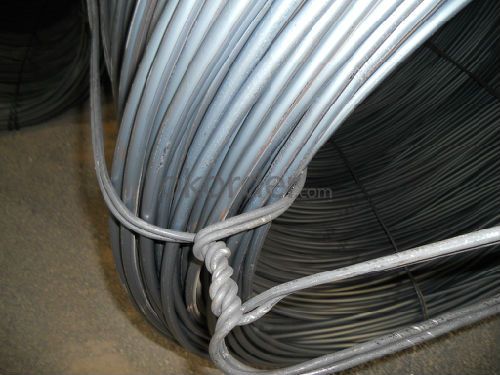
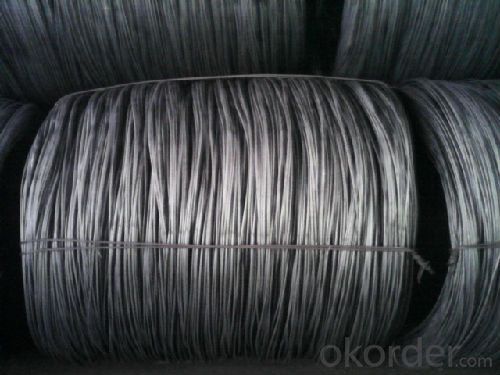
- Q: How is the corrosion resistance of steel wire rod evaluated?
- The corrosion resistance of steel wire rod is typically evaluated through various tests and assessments. These may include conducting salt spray tests to simulate harsh environmental conditions, measuring the rate of corrosion using electrochemical techniques like polarization resistance or linear polarization, and analyzing the composition and microstructure of the wire rod to determine its susceptibility to corrosion. Additionally, real-world exposure tests and long-term monitoring are often carried out to assess the overall performance and durability of the steel wire rod in corrosive environments.
- Q: How is steel wire rod used in the manufacturing of wire forms for bridge cables?
- Steel wire rod is used in the manufacturing of wire forms for bridge cables as it serves as the primary raw material. The wire rod is first drawn through a series of dies to reduce its diameter and increase its strength. This process, known as wire drawing, ensures that the resulting wire is of high quality and meets the required specifications for bridge cables. The wire is then further processed and formed into various shapes and sizes to create the wire forms used in bridge construction. These wire forms are crucial for providing the structural support and tensile strength needed to withstand the heavy loads and stresses experienced by bridge cables.
- Q: What are the different surface finishing materials used for steel wire rod?
- Steel wire rod can be finished with various materials, each offering unique advantages. Common options include: 1. Galvanizing: Also known as zinc coating, this method involves applying a layer of zinc to the wire rod's surface using hot-dip or electroplating techniques. The zinc coating acts as a sacrificial anode, guarding against corrosion and providing excellent rust protection. 2. Phosphate Coating: This technique involves treating the wire rod with a phosphate solution, resulting in a thin layer of phosphate crystals on the surface. This coating enhances the adhesion of subsequent coatings and improves corrosion resistance. 3. Epoxy Coating: A thermosetting polymer, epoxy coating is applied as a protective layer on the wire rod's surface. It offers exceptional resistance to chemicals, abrasion, and corrosion, thus increasing the rod's durability and lifespan. 4. Powder Coating: This popular method uses an electrostatic process to apply a dry powder to the wire rod's surface. The powder is then cured under heat, forming a durable and attractive coating. Powder coating provides a wide range of colors and finishes, improved resistance to chipping and scratching, and enhanced corrosion protection. 5. Chrome Plating: In this process, a layer of chromium is deposited onto the wire rod's surface. Chrome plating not only offers excellent corrosion and wear resistance but also provides a decorative finish. It is commonly used when aesthetics, durability, and corrosion protection are essential. 6. Nickel Plating: Nickel plating involves depositing a layer of nickel onto the wire rod's surface. This plating enhances corrosion resistance, creates a bright finish, improves solderability, and facilitates better electrical conductivity. These are just a few examples of the diverse range of surface finishing materials used for steel wire rod. The choice of coating or plating depends on specific application requirements, such as corrosion resistance, aesthetics, and functional properties.
- Q: How is the surface quality of steel wire rod assessed?
- The surface quality of steel wire rods is assessed through various methods and criteria. One of the primary parameters used to evaluate the surface quality is the presence of defects such as cracks, scratches, pits, or scale. These defects can significantly affect the performance and reliability of the wire rod. Visual inspection is the initial step in assessing the surface quality. Skilled operators examine the wire rods for any visible defects using proper lighting and magnification tools. This method allows for the detection of larger defects that may affect the wire rod's strength and appearance. Another important technique is non-destructive testing (NDT), which includes methods like ultrasonic testing, eddy current testing, and magnetic particle inspection. These methods help identify internal defects that may not be visible to the naked eye. Ultrasonic testing utilizes high-frequency sound waves to detect internal cracks or voids. Eddy current testing uses electromagnetic induction to evaluate the conductivity and surface condition of the wire rod. Magnetic particle inspection involves applying magnetic particles to the surface of the wire rod, which then reveals any defects by forming visible indications. In addition to these methods, dimensional checks are performed to ensure the wire rod meets the required specifications. This includes measuring parameters such as diameter, roundness, and straightness. Any deviations from the specified dimensions can indicate surface irregularities. Overall, the assessment of surface quality in steel wire rods involves a combination of visual inspection, non-destructive testing, and dimensional checks. By employing these techniques, manufacturers can ensure that the wire rods meet the required quality standards and are suitable for various applications such as automotive components, construction materials, and electrical wires.
- Q: What are the common recycling methods for steel wire rod?
- The common recycling methods for steel wire rod include melting and remolding the wire rod into new steel products, such as bars or coils, and using it as raw material in the production of other steel products. Additionally, the wire rod can be shredded and processed to extract any remaining non-ferrous materials, such as copper or aluminum, for separate recycling.
- Q: How is steel wire rod used in the production of fencing and mesh?
- Steel wire rod plays a crucial role in producing fencing and mesh due to its strength, durability, and versatility. These qualities make it an excellent material for creating fences and mesh that can withstand different environmental conditions and provide a high level of security. To manufacture steel wire rod, it goes through hot rolling or cold drawing in the production process. Afterward, the wire rod undergoes further processing to transform it into various forms such as wires, bars, and strands. These forms are then used to create the different components needed for fencing and mesh. When it comes to fencing, steel wire rod is commonly used to create the main structural components like posts and rails. Typically, the wire rod is bent and welded to achieve the desired shape and size. These components are then interconnected and reinforced with additional wires, also made from steel wire rod, to create a sturdy fence structure. Steel wire rod is also utilized in making the mesh or netting of the fence. The wire rod is drawn into thin and flexible wires, which are tightly woven or welded together to form a mesh pattern. This mesh is then attached to the fence posts and rails, providing a secure barrier while allowing visibility and ventilation. Moreover, steel wire rod is employed to create different types of fencing and mesh, including chain-link fences, welded wire mesh, and expanded metal mesh. Each type has its own unique characteristics and applications, but they all rely on the strength and durability of steel wire rod to offer security and protection. In conclusion, incorporating steel wire rod in the production of fencing and mesh ensures that these structures are robust, long-lasting, and capable of enduring harsh conditions. The versatility of steel wire rod allows for the creation of various fence and mesh designs, making it an indispensable material in the construction industry.
- Q: What are the common industry standards for steel wire rod?
- The common industry standards for steel wire rod include specifications such as the American Society for Testing and Materials (ASTM) A510, A510M, and A580, as well as the International Organization for Standardization (ISO) 16120 and 16124. These standards outline the requirements for the quality, dimensions, mechanical properties, and testing procedures of steel wire rod used in various industries.
- Q: How is steel wire rod used in the production of wire mesh for agricultural fencing?
- Steel wire rod is used in the production of wire mesh for agricultural fencing by being drawn into thin, continuous strands that are then woven or welded together to create a strong and durable mesh. This mesh is used to form the structure of the agricultural fence, providing a barrier that secures livestock and crops while also allowing visibility and airflow. The high tensile strength and corrosion resistance of steel wire rod make it an ideal choice for withstanding the harsh outdoor conditions and ensuring the longevity of the wire mesh fencing.
- Q: What are the different types of steel wire rod finishes for improved chemical resistance?
- There are several types of steel wire rod finishes that can improve chemical resistance. These include galvanized finishes, which involve coating the wire rod with a layer of zinc to protect it from corrosion caused by chemicals. Another option is stainless steel finishes, where the wire rod is made from a stainless steel alloy that is highly resistant to chemical corrosion. Additionally, there are epoxy-coated finishes, where a layer of epoxy resin is applied to the wire rod to provide an extra barrier against chemical contact.
- Q: How are steel wire rods used in the manufacturing of bicycle spokes for strength and flexibility?
- The manufacturing process of bicycle spokes relies heavily on steel wire rods, which are crucial for providing both strength and flexibility. These rods are essential as they enable optimal performance by withstanding the various forces and stresses encountered during cycling, such as the rider's weight and impacts from uneven surfaces. The strength of steel wire rods holds immense importance in bicycle spokes, as they need to support the rider's weight and transfer the force generated from pedaling to the wheels. Steel is renowned for its high tensile strength, making it capable of resisting significant pulling or stretching forces without breaking. This characteristic makes it an ideal material for bicycle spokes that must sustain the rider's weight and maintain stability. Additionally, steel wire rods offer exceptional flexibility, allowing the spokes to efficiently absorb and distribute external forces. This flexibility plays a significant role in shock absorption and vibration reduction, thus minimizing the impact on the overall structure of the bicycle and enhancing the rider's comfort. Manufacturers typically shape the steel wire rods into specific profiles to optimize both strength and flexibility. Often, these rods undergo a cold-drawing process, which further enhances their tensile strength while preserving their flexibility. As a result, cold-drawn steel wire rods possess the necessary strength to withstand the forces experienced during cycling, yet they retain enough flexibility to enable the spokes to adapt and accommodate different road conditions. In conclusion, the utilization of steel wire rods is indispensably crucial in bicycle spoke manufacturing due to their integral role in providing strength and flexibility. With their high tensile strength, these rods ensure the spokes can effectively bear the rider's weight and transfer forces, while their flexibility aids in shock absorption and vibration reduction. Ultimately, steel wire rods are vital components that guarantee the durability and performance required for spokes in bicycle manufacturing.
Send your message to us
Wire Rod Q195 With High Quality
- Loading Port:
- China Main Port
- Payment Terms:
- TT or LC
- Min Order Qty:
- -
- Supply Capability:
- -
OKorder Service Pledge
OKorder Financial Service
Similar products
Hot products
Hot Searches
Related keywords
